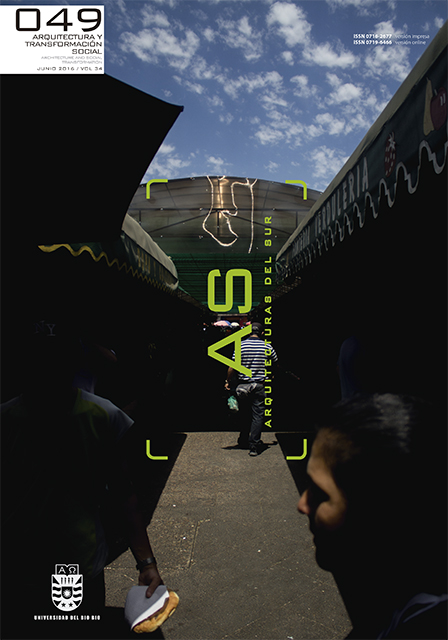Modern Movement apartment buildings in Camagüey: Preserving valuable heritage through projects and social participation
DOI:
https://doi.org/10.22320/07196466.2016.34.49.06Keywords:
pilot project, state-owned company, participatory development, social welfare, heritageAbstract
Camagüey’s historic urban center, declared a World Heritage site in 2008, possesses a considerable number of Modern Movement buildings constructed in the decade of the 1950s, which have undergone modifications to fulfill the new needs of their residents. Regretfully, most of these transformations have not received the necessary technical advice or participation of citizens to ensure that both the population ́s requirements are met and the city ́s valuable heritage is protected. Faced with this problem, research projects that coordinate the participation of researcher-academics, professionals and students, are an effective way to achieve successful solutions. Through a historical-architectural property analysis, a detailed diagnostic assessment and the technical judgment of professionals, as well as the incorporation of the resident population via the surveys carried out, this paper addresses mechanisms to ensure an attitude of respect for, and appreciation and awareness of the spatial and environmental conditions that provide solutions for these properties, which are aimed at providing social welfare to those who live there and at the same time should be preserved to bequeath to society.
Downloads
References
ANTEQUERA, Antonio. La situación del patrimonio ur- bano en la periferia de la gran ciudad: patrimonio o cial versus patrimonio identitario. El caso de Carabanchel Alto (Madrid). Escuela Técnica Superior de Arquitectura de Madrid - Universidad Politécnica de Madrid, 2015.
CABALLERO Rivacoba, María Teresa y YORDI García, Mirtha. Desarrollo social y trabajo comunitario. Teoría- metodología y práctica cubana. Camagüey: Editorial Ácana, 2009.
CHAOS, Mabel. La identidad cultural en el centro de la gestión turística de los núcleos monumentales. En: GÓ- MEZ, Lourdes y NIGLIO, Olimpia, Conservación de centros históricos en Cuba. Volumen II. Roma: Editorial edAEsem- pi di Architettura, Aracne Editrice, 2015, pp. 663- 676.
ESQUIVEL, Diango. Lineamientos de conservación de los edi cios multifamiliares del movimiento moderno del centro histórico de la ciudad de Camagüey. Tesis Máster en Conservación de Centros Históricos y Rehabilitación del Patrimonio Edi cado. Facultad de Arquitectura de Camagüey, 2011.
GUERRA, Marisela, MORALES, Carlos Manuel., DE LA CRUZ, Suzel. Educar para la conservación de la biodiver- sidad en los parques urbanos. Transformación, enero- junio 2014. , vol. 1, n°10 pág. 29 - 39.
MANCEBO, Ingrid., CHAOS, Mabel Teresa y MATAMO- ROS, Mabel. Impacto de las transformaciones en el hábitat de ciudades patrimoniales. Memorias del X Sim- posio Internacional Desafíos en el Manejo y Gestión de las Ciudades. Camagüey, febrero del 2016, pág.1- 2.
RODRÍGUEZ, Eduardo Luis. La década incógnita. Los cin- cuenta: modernidad, identidad, y algo más. Arquitectura Cuba, 1997, n° 376, pp. 36-43.
RIGOL, Isabel y ROJAS, Ángela. Conservación patrimo- nial: teoría y crítica, Cuba: Universidad de La Habana, 2015.
SALGADO, Antonio. La Vivienda. En Busca del Sentido Perdido. En: Narváez, Adolfo. Hábitat y vivienda en América. Ciudad Universitaria, México: Universidad Autónoma de Nuevo León, 2002, pp. 22-24.
SEGRE, Roberto. Lectura crítica del entorno cubano. La Habana: Editorial Letras Cubanas,1990.
Downloads
Published
How to Cite
Issue
Section
License
Copyright (c) 2016 Dianelis Falls Valdivieso

This work is licensed under a Creative Commons Attribution-ShareAlike 4.0 International License.
The content of the articles published in each issue of Arquitecturas del Sur is the sole responsibility of the authors and does not necessarily represent the opinion of University of the Bío-Bío.
The authors will maintain their copyright; however, they will guarantee the journal the right to first publication and dissemination of their work. The publication of the article in Arquitecturas del Sur will be subject to the Creative Commons International license (CC BY-SA) that allows others to adapt: remix, transform and build on the material for any purpose, even commercially; share: copy and redistribute the material in any medium or format, as long as the authorship and first publication in this journal are acknowledged by citing them correctly, and their new contributions are under a license with the same terms.














 Programa de Información Científica/Concurso Fondos de Publicación de Revistas Científicas 2018/ Proyecto Mejoramiento de Visibilidad de Revistas UBB (Código:FP180007)
Programa de Información Científica/Concurso Fondos de Publicación de Revistas Científicas 2018/ Proyecto Mejoramiento de Visibilidad de Revistas UBB (Código:FP180007) 
